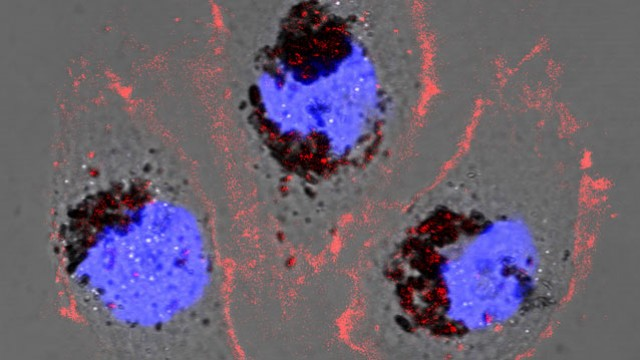Jul 9 2020
Scientists from Northwestern University have now produced a new kind of melanin doped with selenium. Dubbed selenomelanin, this novel biomaterial has excellent potential for protecting human tissues from dangerous radiation.
 Human cells treated with selenomelanin nanoparticles. Image Credit: Northwestern University.
Human cells treated with selenomelanin nanoparticles. Image Credit: Northwestern University.
Given the increased interest in space travel and the general need for lightweight, multifunctional and radioprotective biomaterials, we’ve become excited about the potential of melanin. It occurred to our postdoctoral fellow Wei Cao that melanin containing selenium would offer better protection than other forms of melanin.
Nathan Gianneschi, Study Lead, Northwestern University
Gianneschi continued, “That brought up the intriguing possibility that this as-yet undiscovered melanin may very well exist in nature, being used in this way. So we skipped the discovery part and decided to make it ourselves.”
The study was recently published online in the Journal of the American Chemical Society on July 8th, 2020, well ahead of publication in the July print edition.
Gianneschi is the Jacob and Rosalind Cohn Professor of Chemistry in Weinberg College of Arts and Sciences at Northwestern University and is also an associate director of the International Institute for Nanotechnology. Cao is the first author of the study.
Melanin is present in a majority of the organisms across the animal and plant kingdoms, and also in fungi and bacteria. Although melanin is best known for pigmentation, it also offers excellent protection against harmful radiation.
Nature contains five types of melanin. But compared to the more common eumelanin (brown pigment and black pigment found in dark hair), pheomelanin—the pigment found in red hair—has been demonstrated to absorb X-rays more efficiently.
Unnecessary radiation exposure happens during several common activities, right from air travel to clinical radiation therapy and X-ray diagnosis. In extreme situations such as human space travel or breakdown of nuclear reactors, unwanted radiation exposure presents an even greater concern.
The landmark “Twins Study” of NASA revealed how the DNA of astronaut Scott Kelly was damaged because of his year in orbit. An astronaut sent on a Mars mission is likely to receive radiation that is up to 700 times more than that on the Earth.
When compared to the bulk and weight of conventional radioprotective materials such as lead, melanin is not only lighter but also more flexible in how it can be employed. At present, samples of melanin are in orbit at the International Space Station, and are being investigated by another research group to test the material’s reaction to radiation exposure.
Pheomelanin, which has been the focus of recent studies, contains sulfur; sulfur is believed to be the perfect candidate for that purpose. But Gianneschi’s research group hypothesized that a new form of melanin—doped with selenium rather than sulfur—would offer more improved protection from X-rays.
Selenium—an essential micronutrient—plays a crucial role in the prevention of cancer, and according to earlier reports, selenium compounds can protect animals from harmful radiation. While such compounds are known to be present in normal human proteins, they have not been linked to the natural melanin before.
The novel biomaterial was produced by Gianneschi’s research team, who dubbed it “selenomelanin,” and used it for treating living cells. For comparison purposes, the researchers also prepared cells treated with synthetic eumelanin and pheomelanin, and also cells that lack protective melanin.
After getting a radiation dose that would be toxic to human beings, only the selenomelanin-treated cells continued to display a normal cell cycle.
Our results demonstrated that selenomelanin offers superior protection from radiation. We also found that it was easier to synthesize selenomelanin than pheomelanin, and what we created was closer than synthetic pheomelanin to the melanin found in nature.
Nathan Gianneschi, Study Lead, Northwestern University
Additional testing with microorganisms revealed that selenomelanin can also be biosynthesized, which means live cells that receive suitable nutrients can subsequently synthesize selenomelanin on their own—and still retain its radioprotective characteristics.
As a matter of fact, the scientists produced selenomelanin in their laboratory, but assumed that it may already exist in nature.
“With an abundant source of selenium in the environment, some organisms may have been able to adapt to extreme circumstances such as radiation through the beneficial effects of selenomelanin,” added Gianneschi.
Our work points to the possibility that melanin may act as a repository for selenium, helping ensure that organisms benefit from it. Selenomelanin may play an important role in how selenium is metabolized and distributed biologically. It’s an area for further investigation.
Wei Cao, Postdoctoral Fellow, Northwestern University
Gianneschi and his research group believe that this novel biomaterial could be used on an individual’s skin, similar to a melanin-based sunscreen. The biomaterial could even be used as a protective film to guard materials from harmful radiation while in transit.
Gianneschi is also a professor of biomedical engineering and materials science and engineering in the McCormick School of Engineering. He is also a member of the Chemistry of Life Processes Institute, Simpson Querrey Institute, and Robert H. Lurie Comprehensive Cancer Center of Northwestern University.
The study titled “Selenomelanin: An abiotic selenium analogue of pheomelanin” was funded by the Air Force Office of Scientific Research via a MURI Grant (FA9550-18-1-0142) and a supplemental grant (AFOSR FA9550-18-1-0477).
The MURI collaboration comprised Michael D. Burkart from the University of California San Diego, Matthew D. Shawkey from the University of Ghent, and Ali Dhinojwala from the University of Akron, and also Zheng Wang from the U.S. Navy and Michael R. Wasielewski from Northwestern University.
Journal Reference:
Cao, W., et al. (2020) Selenomelanin: An Abiotic Selenium Analogue of Pheomelanin. Journal of American Chemical Society. doi.org/10.1021/jacs.0c05573.